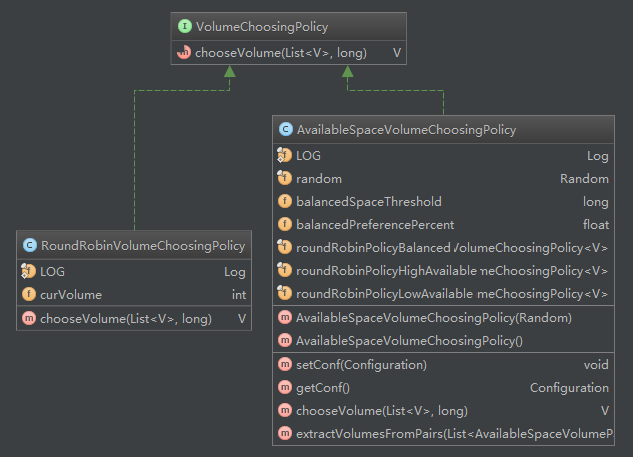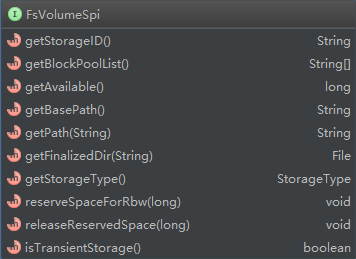问题描述:
Hadoop集群在运行一段时间后会出现一个问题:由于集群节点众多,某个节点上的磁盘坏掉,然后换了新盘。那么新盘相对于同节点上的其他数据盘会有更多的剩余空间。
解决办法:
在hadoop2.0中,datanode数据副本存放磁盘选择策略有两种方式
第一种是沿用hadoop1.0的磁盘目录轮询方式,实现类:RoundRobinVolumeChoosingPolicy.java
如果不配置,默认使用第一种方式,既轮询选择磁盘来存储数据副本,但是轮询的方式虽然能够保证所有磁盘都能够被使用,但是经常会出现各个磁盘直接数据存储不均衡问题,有的磁盘存储得很满了,而有的磁盘可能还有很多存储空间没有得到利用。这种策略很容易导致节点内的磁盘使用不均衡。
第二种是选择可用空间足够多的磁盘方式存储,实现类:AvailableSpaceVolumeChoosingPolicy.java
选择策略对应的配置项是:
<property>
<name>dfs.datanode.fsdataset.volume.choosing.policy</name>
<value>org.apache.hadoop.hdfs.server.datanode.fsdataset.AvailableSpaceVolumeChoosingPolicy</value>
</property>
在采用第二种方式时还有另外两个参数会用到:
dfs.datanode.available-space-volume-choosing-policy.balanced-space-threshold
默认值是10737418240,既10G,一般使用默认值就行,以下是该选项的官方解释:
This setting controls how much DN volumes are allowed to differ in terms of bytes of free disk space before they are considered imbalanced. If the free space of all the volumes are within this range of each other, the volumes will be considered balanced and block assignments will be done on a pure round robin basis.
意思是首先计算出两个值,一个是所有磁盘中最大可用空间,另外一个值是所有磁盘中最小可用空间,如果这两个值相差小于该配置项指定的阀值时,则就用轮询方式的磁盘选择策略选择磁盘存储数据副本。源代码如下:
ublic boolean areAllVolumesWithinFreeSpaceThreshold() {
long leastAvailable = Long.MAX_VALUE;
long mostAvailable = 0;
for (AvailableSpaceVolumePair volume : volumes) {
leastAvailable = Math.min(leastAvailable, volume.getAvailable());
mostAvailable = Math.max(mostAvailable, volume.getAvailable());
}
return (mostAvailable - leastAvailable) < balancedSpaceThreshold;
}
dfs.datanode.available-space-volume-choosing-policy.balanced-space-preference-fraction
默认值是0.75f,一般使用默认值就行,以下是该选项的官方解释:
This setting controls what percentage of new block allocations will be sent to volumes with more available disk space than others. This setting should be in the range 0.0 - 1.0, though in practice 0.5 - 1.0, since there should be no reason to prefer that volumes with
意思是有多少比例的数据副本应该存储到剩余空间足够多的磁盘上。该配置项取值范围是0.0-1.0,一般取0.5-1.0,如果配置太小,会导致剩余空间足够的磁盘实际上没分配足够的数据副本,而剩余空间不足的磁盘取需要存储更多的数据副本,导致磁盘数据存储不均衡。
VolumeChoosingPolicy源码


接口VolumeChoosingPolicy,方法chooseVolume从datanode磁盘目录中选择一个节点的磁盘FsVolumeSpi的实现。FsVolumeSpi的实现类为FsVolumeImpl。
/**
* This interface specifies the policy for choosing volumes to store replicas.
*/
@InterfaceAudience.Private
public interface VolumeChoosingPolicy<V extends FsVolumeSpi> {
/**
* Choose a volume to place a replica,
* given a list of volumes and the replica size sought for storage.
*
* The implementations of this interface must be thread-safe.
*
* @param volumes - a list of available volumes.
* @param replicaSize - the size of the replica for which a volume is sought.
* @return the chosen volume.
* @throws IOException when disks are unavailable or are full.
*/
public V chooseVolume(List<V> volumes, long replicaSize) throws IOException;
} |
RoundRobinVolumeChoosingPolicy采用轮询方式进行遍历可用空间足够的磁盘。核心的代码如下
/**
* Choose volumes in round-robin order.
*/
public class RoundRobinVolumeChoosingPolicy<V extends FsVolumeSpi>
implements VolumeChoosingPolicy<V> {
public static final Log LOG = LogFactory.getLog(RoundRobinVolumeChoosingPolicy.class);
private int curVolume = 0;
@Override
public synchronized V chooseVolume(final List<V> volumes, long blockSize)
throws IOException {//同步调用,datanode每次需要调用选择磁盘进行块写入时调用
if(volumes.size() < 1) {
throw new DiskOutOfSpaceException("No more available volumes");
}
// since volumes could've been removed because of the failure
// make sure we are not out of bounds
if(curVolume >= volumes.size()) {
curVolume = 0;
}
int startVolume = curVolume;
long maxAvailable = 0;
while (true) {
final V volume = volumes.get(curVolume);
curVolume = (curVolume + 1) % volumes.size();//每次从当前volume加一,然后判断可用空间是否足够
long availableVolumeSize = volume.getAvailable();
if (availableVolumeSize > blockSize) {
return volume;
}
if (availableVolumeSize > maxAvailable) {
maxAvailable = availableVolumeSize;
}
if (curVolume == startVolume) {
throw new DiskOutOfSpaceException("Out of space: "
+ "The volume with the most available space (=" + maxAvailable
+ " B) is less than the block size (=" + blockSize + " B).");
}
}
}
} |
AvailableSpaceVolumeChoosingPolicy
public synchronized V chooseVolume(List<V> volumes,
long replicaSize) throws IOException {
if (volumes.size() < 1) {
throw new DiskOutOfSpaceException("No more available volumes");
}
AvailableSpaceVolumeList volumesWithSpaces =
new AvailableSpaceVolumeList(volumes);//先从volumes包装成AvailableSpaceVolumeList,然后下面进行判断
if (volumesWithSpaces.areAllVolumesWithinFreeSpaceThreshold()) {//全部volume中空间最大减去最小不超过参数阈值设置,则调用轮询的策略
// If they're actually not too far out of whack, fall back on pure round
// robin.
V volume = roundRobinPolicyBalanced.chooseVolume(volumes, replicaSize);
if (LOG.isDebugEnabled()) {
LOG.debug("All volumes are within the configured free space balance " +
"threshold. Selecting " + volume + " for write of block size " +
replicaSize);
}
return volume;
} else {//全部volume中空间最大减去最小超过参数阈值设置
V volume = null;
// If none of the volumes with low free space have enough space for the
// replica, always try to choose a volume with a lot of free space.
long mostAvailableAmongLowVolumes = volumesWithSpaces
.getMostAvailableSpaceAmongVolumesWithLowAvailableSpace();
//先从volume中去的最少可用空间和最大可用空间。
//"最小可用空间"到"最小可用空间+阈值"之间的为lowAvailableVolumes
//"最小可用空间+阈值"到"最大可用空间"之间的为highAvailableVolumes
//举例:volumes中最小可用空间为100G,最大可用空间为150G,阈值设置为20G,则100G~120G的volumes为lowAvailableVolumes,120G~150G的volumes为highAvailableVolumes。
List<V> highAvailableVolumes = extractVolumesFromPairs(
volumesWithSpaces.getVolumesWithHighAvailableSpace());
List<V> lowAvailableVolumes = extractVolumesFromPairs(
volumesWithSpaces.getVolumesWithLowAvailableSpace());
//
float preferencePercentScaler =
(highAvailableVolumes.size() * balancedPreferencePercent) +
(lowAvailableVolumes.size() * (1 - balancedPreferencePercent));
float scaledPreferencePercent =
(highAvailableVolumes.size() * balancedPreferencePercent) /
preferencePercentScaler;
//选择在highAvailableVolumes中进行轮询的条件有两个之一即可:
//1、在lowAvailableVolumes中,如果最大可用空间小于块大小;
//2、满足公式random.nextFloat() < (highAvailableVolumes.size() * balancedPreferencePercent)/(highAvailableVolumes.size() * balancedPreferencePercent) + (lowAvailableVolumes.size() * (1 - balancedPreferencePercent))
//我们举例来进行描述,受限最小可用空间为100G,最大可用空间为150G,阈值为20G,balancedPreferencePercent阈值为默认0.75.下面用5个盘来说明,一步步解析上面的公式。
// 100G 110G 130G 140G 150G
//|<- lowAvailableVolumes ->|<- highAvailableVolumes ->|
//highAvailableVolumes.size() = 3
//lowAvailableVolumes.size() = 2
//balancedPreferencePercent=0.75
//(highAvailableVolumes.size() * balancedPreferencePercent)/(highAvailableVolumes.size() * balancedPreferencePercent) + (lowAvailableVolumes.size() * (1 - balancedPreferencePercent))
//(3 * 0.75 )/(3 * 0.75 ) + (2 * (1 - 0.75 ))
//这个公式其实根据balancedPreferencePercent在0到1之间的取值,生成0到1的值。分子是highAvailableVolumes.size()*balancedPreferencePercent所以,当balancedPreferencePercent越大时,那么公式最终值越接近1.
//random.nextFloat()取值为0~1,若公式最终值越接近1,那么random.nextFloat() <的可能性越高,也就越会进行highAvailableVolumes进行轮询写入块了。
if (mostAvailableAmongLowVolumes < replicaSize ||
random.nextFloat() < scaledPreferencePercent) {
volume = roundRobinPolicyHighAvailable.chooseVolume(
highAvailableVolumes, replicaSize);
if (LOG.isDebugEnabled()) {
LOG.debug("Volumes are imbalanced. Selecting " + volume +
" from high available space volumes for write of block size "
+ replicaSize);
}
} else {
volume = roundRobinPolicyLowAvailable.chooseVolume(
lowAvailableVolumes, replicaSize);
if (LOG.isDebugEnabled()) {
LOG.debug("Volumes are imbalanced. Selecting " + volume +
" from low available space volumes for write of block size "
+ replicaSize);
}
}
return volume;
}
} |






















 3496
3496











 被折叠的 条评论
为什么被折叠?
被折叠的 条评论
为什么被折叠?








